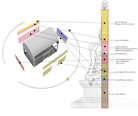Reflecting its interdisciplinary nature, this project combines two complementary scientific concerns: on the one hand, the advancement of historical knowledge about Qianlong thanks to the ornamental programme of his tomb; on the other, the advancement of the knowledge needed to design and develop representation systems that are genuine tools for scientific investigation and visualisation. The ‘3D spatialisation’ of the inscriptions and iconography in Qianlong’s tomb clearly demonstrates the creation of a virtual stupa thanks to the particular layout of the texts. The construction of this system is based on linking the graphic and computer representation of two parallel levels of description. On the one hand, the description of the morphology of the tomb through the structuring of spatialised geometric entities within a 3D model (collection of architectural forms and spatial relationships), and on the other, the description of knowledge related to Tibetan funerary rituals (abstract concepts and semantic relationships). The graphical and textual data formalised and represented in this way then become accessible within an analysis medium (information system) enabling the relationships between the morphological and conceptual description of the tomb to be explored through three interconnected interactive devices: a 3D scene enabling the physical space to be explored in its entirety, a graph enabling navigation within a network of interconnected abstract concepts, and a dynamic image visualising the theoretical position of the inscriptions (and associated concepts) within a virtual stupa. A real work tool for specialist researchers in the field, this system enables physical and conceptual space to be explored in parallel: an observation point in the 3D scene (or the selection of an entity) corresponds to the relative view (or relative concept) within the concept graph, and vice versa. This system, developed as a web application, enables us to explore and analyse the modalities and extreme sophistication of the use of the written word in Qianlong’s tomb. In the future, it will make it possible to make the most of all the data it contains and compare it with that found in other buildings or on objects used in a funerary context.
Calendar : 2009-2012. Projet ANR (Agence Nationale de la Recherche)
Partners : CRCAO (UMR 8155 CNRS/EPHE/Collège de France), MAP (UMR 3495 CNRS/MCC), IGN
Scientific coordination :Françoise Wang, CRCAO / Livio De Luca, MAP
Photogrammetric treatments: Marc-Pierrot Deseilligny, IGN-ENSG
Graphical rendering and semantic annotation : Francesca De Domenico
Analysis of inscriptions : WEI Wen, AN Haiyan, Zeng Hancheng
3D Modelisation: Chawee Busayarat
IT developments: Julie Lombardo, Chiara Stefani
Contact : Livio De Luca

Must read : Wang, F., De Luca L. Sinetomb : La représentation sémantique de l’espace. Lettre de l’INSHS No.18 (juillet 20212), p. 7-9. https://www.inshs.cnrs.fr/sites/institut_inshs/files/download-file/lettre_infoINSHS_18HD-min.pdf
